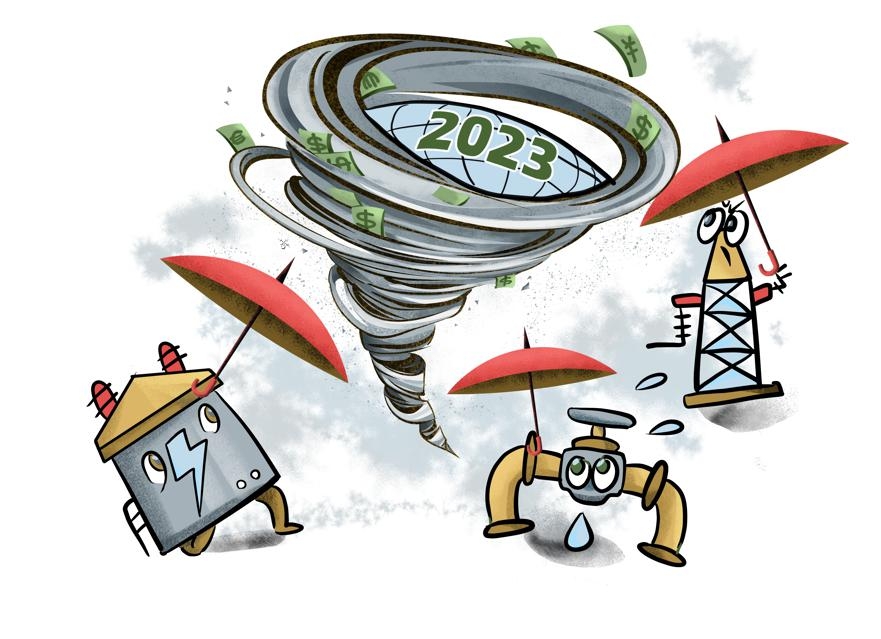World must avoid fragmentation
Now is a particularly challenging time for the global economy with the outlook expected to darken in 2023.
Three powerful forces are holding back the global economy: the conflict between Russia and Ukraine, the need to tighten monetary policy amid the cost-of-living crisis and persistent and broadening inflation pressures, and the slowdown of the Chinese economy.
During the International Monetary Fund’s annual meetings in October, we projected global growth to slow from 6.0 percent last year to 3.2 percent this year. And, for 2023, we lowered our forecast to 2.7 percent — 0.2 percentage points lower than projected a few months earlier in July.
We expect the global slowdown to be broad-based, with countries accounting for one-third of the global economy contracting this year or next. The three largest economies: the United States, China, and the euro area, will continue to stall.
There is a one in four chance that global growth next year could fall below 2 percent — a historical low. In short, the worst is yet to come and, some major economies, such as Germany, are expected to enter recession next year.
Let’s take a look at the world’s largest economies:
In the United States, tightening monetary and financial conditions mean growth could be about 1 percent in 2023.
In China, we have lowered next year’s growth forecast to 4.4 percent due to the weakening property sector, and weaker global demand.
In the eurozone, the energy crisis caused by the Russia-Ukraine conflict is taking a heavy toll, reducing our growth projection for 2023 to 0.5 percent.
Almost everywhere, rapidly rising prices, especially those of food and energy, are causing serious hardships for vulnerable households.
Despite the slowdown, inflation pressures are proving broader and more persistent than anticipated. Global inflation is now expected to peak at 9.5 percent in 2022 before decelerating to 4.1 percent by 2024. Inflation is also broadening beyond food and energy.
The outlook could worsen further and policy trade-offs have become acutely challenging. Here are four key risks:
The risk of monetary, fiscal, or financial policy miscalibration has risen sharply at a time of high uncertainty.
Turmoil in financial markets could cause global financial conditions to deteriorate, and the US dollar to strengthen further.
Inflation could, yet again, prove more persistent, especially if labor markets remain extremely tight.
Finally, the hostilities in Ukraine are still raging. Further escalation would exacerbate the energy and food security crisis.
Increasing price pressures remain the most immediate threat to current and future prosperity by squeezing real incomes and undermining macroeconomic stability. Central banks are now focused on restoring price stability, and the pace of tightening has accelerated sharply.
Where necessary, financial policy should ensure that markets remain stable. However, central banks around the world need to keep a steady hand, with monetary policy firmly focused on taming inflation.
The strength of the US dollar is also a major challenge. The dollar is now at its strongest since the early 2000s. So far, this rise appears mostly driven by fundamental forces such as the tightening of monetary policy in the US and the energy crisis.
The appropriate response is to calibrate monetary policy to maintain price stability, while letting exchange rates adjust, conserving valuable foreign exchange reserves for when financial conditions really worsen.
As the global economy is headed for stormy waters, now is the time for emerging market policymakers to batten down the hatches.
Energy to dominate Europe’s outlook
The outlook for next year looks pretty grim. We see the eurozone’s GDP contracting 0.1 percent in 2023, which is slightly below consensus.
However, a successful fall in demand for energy — aided by seasonally warm weather — and gas storage levels at near 100 percent capacity diminishes the risk of hard energy rationing during this winter.
By mid-year, the situation should improve as falling inflation allows for gains in real incomes and a recovery in the industrial sector. But with almost no Russian pipeline gas flowing into Europe next year, the continent will need to replace all the lost energy supplies.
So the 2023 macro story will largely be dictated by energy. An improved outlook for nuclear and hydroelectric output combined with a permanent degree of energy savings and fuel substitution away from gas means Europe could switch away from Russian gas without suffering a deep economic crisis.
We expect inflation to be lower in 2023, although the extended period of high prices this year poses a greater risk of higher inflation.
And with the near total end of Russian gas imports, Europe’s efforts at replenishing inventories could push gas prices up in 2023.
The picture for core inflation looks less benign than for the headline figure, and we expect it to be high again in 2023, averaging 3.7 percent. A strong disinflationary trend coming from goods and a much stickier dynamic in service prices will shape the behavior of core inflation.
Non-energy goods inflation is high now, because of a shift in demand, persistent supply issues and pass-through of energy costs.
But the decline in global commodity prices, easing supply chain tensions, and high levels of the inventories-to-orders ratio suggest a turnaround is imminent.
With services representing two-thirds of the core, and over 40 percent of the total inflation, that’s where the real battleground for inflation will be in 2023.
Post time: Dec-16-2022







